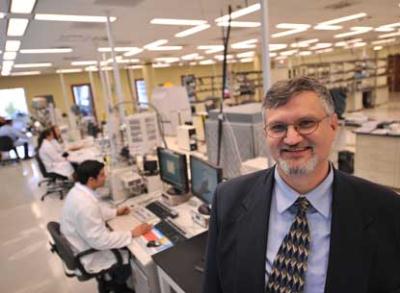Dec 13 2012
A VCU research team, led by Everett Carpenter Ph.D., associate professor of inorganic and materials chemistry and affiliate professor of chemical and life science engineering in the VCU College of Humanities and Sciences, has been selected to participate in the inaugural I-Corp at ARPA-E program to help academic scientists expand their focus in ways to transition technology from basic research to commercial applications.
 Everett Carpenter
Everett Carpenter
ARPA-E is the U.S. Department of Energy’s Advanced Research Projects Agency-Energy (ARPA-E).
The program is part of the National Science Foundation Innovation Corps Team program (NSF I-Corps Teams) and will focus on developing new rare-earth free permanent magnets for energy efficient electric car motors or wind generators.
The I-Corps Team program was designed to help scientists and engineers to not only develop and nurture fundamental research, but also to translate it into technologies, products and processes that may ultimately benefit society. The grant will provide the team with access to resources to help determine the readiness to transition the technology.
Carpenter, who is also director of VCU NANOCenter, is joined by Daniel Hudgins, a fourth-year graduate student in his research group, and Vincent G. Harris, founder and chair of Metamagnetics, Inc. The team is called Nanofoundry. Carpenter serves as principal investigator and Hudgins the entrepreneurial lead, and Harris will serve as the entrepreneurial mentor.
“This is an extremely prestigious award which will help add credibility to our team if and when we decide to create a spin-off company,” said Carpenter.
“The program will help us connect with other teams and learn from their successes and failures. In addition, it will help us to connect with potential funding groups to further advance our goal of a spin-off company."
The VCU project was sparked by a push for more energy-efficient and green-powered technologies. Materials scientists are particularly interested in creating permanent magnets that can perform equivalent to the best commercial magnets, and are less expensive than what is available on the market – without relying on rare earth elements. Rare earth elements are difficult and costly to process and refine the metal.
The goal of the three-year project is to use the magnetic carbide-based composite – which looks like a fine black powder – to develop a magnet for use in a prototype electric motor. The transition metal carbide nanomagnets, which require no rare earth elements, are being developed by Carpenter and his team.
According to Carpenter, the program, if successful, would result in the first commercially viable rare-earth free magnet in nearly 50 years.
Earlier this year, the team became one of 14 projects to be funded through ARPA-E’s Rare Earth Alternatives in Critical Technologies program, or REACT. The REACT program is focused on the development of alternatives to rare earth elements, which are minerals that occur naturally in the environment, for use in technologies such as electric motor and generator applications.